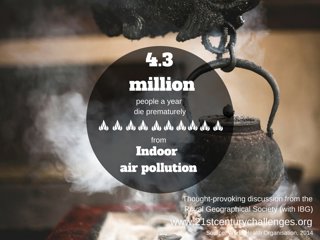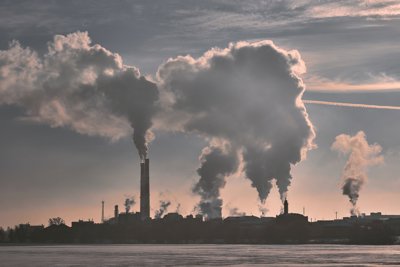What’s the challenge?
The World Health Organisation (WHO) attributed 3.7 million premature deaths worldwide in 2012 to outdoor air pollution and even more, 4.3 million deaths to indoor air pollution. Exposure to toxic smoke from burning solid fuels such as wood and coal is a particular problem in Asia and Africa. How can we prevent deaths across the world from polluted air?
‘Air pollution is the world’s number one environmental health risk’.
World Health Organisation (WHO), 2014
Greenhouse gases and activities to limit the effects of climate change have become far more newsworthy in large sections of the popular media and it is not surprising that air pollution has for a lot of people become synonymous with carbon dioxide emissions.
Yet insufficient focus on air quality has led to some shocking statistics coming from almost every nation and few countries able to claim cleaner air above their cities today compared to ten years ago.
The challenge for geographers is not only how to raise the need for clean air up the political agenda but also how to come up with new and inventive solutions to the increasing levels of particulates in our homes and skies without compromising the economy of our cities. This all needs to be done in a viable and meaningful timeframe so that future generations are not overwhelmed by the legacy of poor air management that we seem set to leave.

Outdoor air pollution
The average human inhales 2,300 gallons of air per day. Urbanisation and the increasing use of diesel-fueled cars, buses and taxis, mean more people than ever before are exposed to harmful particulate soot, carbon monoxide, ozone, nitrogen dioxide and sulfur dioxide. These pollutants increase the risk of diseases such as cancer, heart disease, stroke, pneumonia, and chronic obstructive pulmonary disease (COPD). The World Health Organisation (WHO) attributed 3.7 million premature deaths worldwide in 2012 to outdoor air pollution.
Indoor air pollution
However even more deaths, 4.3 million in 2012 were due to indoor air pollution. 3 billion people around the world, 40% of the population, cook and heat their homes using open fires and simple stoves burning coal or biomass (wood, animal dung and crop waste). Cooking on open flames is inefficient and produces a lot of smoke and harmful particulates. If dwellings are poorly ventilated these particulates can be breathed into the lungs increasing the risk of disease. Exposure to cooking smoke is a particular problem in Asia and Africa. Women and small children are particularly at risk because in traditional communities they spend more time near cookstoves than men.
London’s air pollution
London has had a problem with air pollution for many years. The Great Smog of 1952 was a period of severe air pollution in London lasting five days and killing over 4000 people in the city. It remains the most serious air-pollution event in UK history. It was caused by London’s coal industry emissions in combination with an anticyclone. It led to the creation of the Clean Air Act 1956. Today the problem has changed but is still there. Diesel cars emit harmful nitrogen dioxide (NO2). Pollution is also made worse by certain weather conditions.
What can be done?
Air pollution can be reduced by reducing congestion and density of diesel traffic on roads by creating low emission zones, expanding public transport and supporting pedestrians and cyclists. Free apps and websites of real-time air monitoring aim to raise awareness. The London Air Quality Network have been monitoring air pollution since 1995 using technology. The quality of the air can also be determined by natural indicators such as the cover of lichen which is sensitive to pollution and grows in clean areas.
The Royal Geographical Society (with IBG) held a panel discussion on 30 October 2014 to discuss the issue.
Hear about this challenge from:
Fred Pearce, journalist, author and environment consultant for New Scientist
Frank Kelly, Professor of Environmental health, King’s College London
Frank explains the effects poor air quality has on our health. Professor Frank Kelly is chair in Environmental Health at King’s College London, where he is Director of the Analytical & Environmental Sciences Division. His other positions of responsibility are Director of the Environmental Research Group and Deputy Director of the MRC-PHE Centre for Environment & Health. From these dual positions he is able to combine his two main research interests, namely free radical/antioxidant biochemistry and the impact of atmospheric pollution on human health.
In addition to his academic work Frank is past President of the European Society for Free Radical Research and past Chairman of the British Association for Lung Research. He is also involved with providing policy support to the WHO on air pollution issues and is a member of the Committee on the Medical effects of Air Pollution (COMEAP).
His team are key partners in the NERC funded ClearfLo project and advise the UK Healthy Air Campaign.
Professor Kelly is also an advisor to Invisible Dust, an engagement project which connects scientists and artists and to Catalytic Clothing, an initiative that brings together the worlds of fashion and chemistry to clean the air we breathe.
”It was everyone involved in society thinking, ‘What have we done wrong here’” Professor Frank Kelly, King’s College London
”The issue has not gone away, it’s just changed” Professor Frank Kelly, King’s College London
Poor air quality poses serious threats to health and well-being which include:
-
Asthma
-
Cataracts
-
Low-birth weight
-
Lung cancer
-
Respiratory tract infections
James Thornton
James Thornton is the founding CEO of ClientEarth, Europe’s leading environmental law organisation. The New Statesman named him one of 10 people who could change the world. The Lawyer picked him as one of the top 100 lawyers in the UK, and BusinessGreen selected him as Leader of the Year for 2014.
ClientEarth opened its doors in 2007. Now operating internationally, it uses advocacy, litigation and research to address the greatest challenges of our time—including biodiversity loss, climate change, and toxic chemicals. ClientEarth helps write good laws, and enforces them. With a staff of sixty, it has offices in London, Brussels and Warsaw. In the past two years ClientEarth has won BusinessGreen’s NGO of the Year award and the Law Society’s Excellence award. Its work is frequently featured in the press globally.
James is a member of the bars of New York, California and the Supreme Court of the United States, and a solicitor of England and Wales. He founded the Citizen’s Enforcement Project in NRDC’s New York office, and went on to found the Los Angeles Office of NRDC. He has also served as chief executive in other non profit sectors.
James studied law at New York University Law School, where he was Editor in Chief of the Law Review, then clerked for Judge John Minor Wisdom on the United States Court of Appeals for the Fifth Circuit. He taught environmental law at NYU Law School and City University of New York. He graduated from Yale with the departmental honours in philosophy, Phi Beta Kappa, magna cum laude.
He is the author of two environmental novels: a legal thriller, Immediate Harm, and a sci-fi thriller, Sphinx: The Second Coming.
James is a Zen Buddhist priest in the Soto tradition. He is also a fellow of the Zoological Society of London, The Ashoka Foundation, and the Royal Society of Arts.
Sarah Collins, South Africa-based entrepreneur and Founder of Wonderbag, a non-electric, heat-retention cooker
Sarah grew up on the East Coast of South Africa. Her background is in social development with a huge passion for the environment and conservation. Having spent 10 years in community-based tourism in the Okavango Delta, Botswana, she returned to South Africa in the early 2000s. She realised that poverty alleviation projects were the key to grassroots conservation in Africa. Spending 5 years with the NGO, LoveLife, Sarah implemented an environmental youth leadership programme named Take Back the Future.
Then in 2008, South Africa suffered a series of power cuts. Sarah, frustrated with her half-cooked dinners, remembered how her grandma had surrounded her pans with cushions to keep them cooking after she turned the stove off. So she tried it… and it worked!
Sarah’s thoughts turned to the millions of families in developing countries that cook by burning kerosene, paraffin or wood. These stoves and fires aren’t just polluting, they make entire homes too smoky to breathe in, cause house fires, burn children, swallow wage packets and cause serious illnesses.
“From that night on I knew this was it,” says Sarah. “I became obsessed.”
A good friend of Sarah’s, Moshy Mathe, sewed up the prototype Wonderbag. Amazingly, when tested in labs, food that was heated to boiling point for just a few minutes on the stove and then transferred to the bag, carried on cooking and remained hot for up to 12 hours.
Since 2008, the Wonderbag has been Sarah’s passion and purpose. It has taken 5 years of trial, error and dogged determination to get the Wonderbag to where it is now.
Your questions
Q1 What three things could the next Mayor of London do to ease air quality? (00:05)
Q2 What can big businesses do to improve air quality? (05:40)
Q3 If the UK government is forced by law to comply with air quality targets, will this make them aim for less ambitious targets in future? (10:03)
Q4 What is the situation in China? What are their solutions and priorities? (13:24)
Q5 Can the panel think of any popularly elected politicians who have championed air quality? (17:32)
Q6 How do you advertise the Wonderbag and raise awareness of indoor air pollution to people in remote areas of Africa? (20:41)
Q7 If you were the Mayor of London what would you do in your first week of office to improve air quality? (23:37)
Q8 What impact does Heathrow airport, and a possible expansion, have on air pollution? (24:32)
Q9 As the global middle class expands and demand for luxury items such as cars increases, how can we balance demand with sustainability? (25:30)
Q10 Can China learn anything from Europe regarding air quality policy? (27:15)
Further Reading
The geography of smog, Geographical magazine, March 2015
China’s inconvenient truth: air pollution in a growing city, Geographical magazine, March 2015
London’s pollution should trigger divestment, Geographical magazine, February 2015
